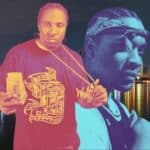The Notorious B.I.G., born Christopher George Latore Wallace on May 21, 1972, was a legendary American rapper who significantly impacted the music world in the 1990s. Known by various stage names such as Biggie Smalls and simply Biggie, he was a key figure in East Coast hip hop and gangsta rap. With his storytelling abilities and distinctive lyrical style, Biggie is often mentioned in lists of the greatest rappers ever.
Hailing from the Bedford-Stuyvesant neighborhood of Brooklyn, New York, Biggie’s rise to fame was marked by his debut album “Ready to Die” in 1994. The album, which showcased his unique flow and gritty storytelling, propelled him into the limelight as a major force in the hip-hop scene. Unfortunately, his career and life were cut short when he was shot and killed in Los Angeles, California, on March 9, 1997.
Despite his untimely death, the influence of The Notorious B.I.G. lives on through his music, posthumous releases, and the next generation of rappers who continue to cite him as an inspiration and a key figure in the evolution of hip-hop.
Early Life and Background
Birth and Family
Christopher George Latore Wallace, better known as Biggie Smalls, was born in Brooklyn, New York on May 21, 1972. Raised in the Bedford-Stuyvesant neighborhood, his mother, Voletta Wallace, was a Jamaican preschool teacher, while his father, Selwyn George Latore, was a small-time politician and welder.
Education
Biggie attended the Roman Catholic Bishop Loughlin Memorial High School, where he developed an interest in rap and hip-hop. He later transferred to George Westinghouse Career and Technical Education High School. While studying there, he crossed paths with future rappers like Busta Rhymes.
Drug Dealing and Legal Issues
Biggie Smalls grew up surrounded by street life, experiencing the crack cocaine epidemic firsthand during his adolescence. Despite his mother’s best efforts, he started selling drugs at a young age. This involvement in drug dealing led to several legal issues, with Biggie serving time on multiple occasions.
Throughout his early life, Biggie Smalls’ experiences in Brooklyn, New York, shaped his personal life and future rap career. His background and struggles instilled a sense of realism in his music, ultimately contributing to his status as one of the greatest rappers of all time.
Career Beginnings
Uptown Records and First Tracks
Christopher George Latore Wallace, better known as Biggie Smalls or The Notorious B.I.G., started his career after being discovered by Mister Cee, a well-known DJ. Mister Cee’s introduction led to Biggie recording a demo tape in 1991, which caught the attention of Uptown Records executive Andre Harrell. Harrell signed Biggie to Uptown Records and introduced him to a young producer named Sean Combs, also known as Puff Daddy, who began to mentor him.
In 1993, Biggie released his first official track, “Party and Bullshit“, featured on the soundtrack of the film Who’s the Man?. This early track showcased his distinct voice, powerful storytelling, and raw talent that would soon define his music career.
Collaboration with Mary J. Blige
One of Biggie’s first major collaborations was with the “Queen of Hip-Hop Soul”, Mary J. Blige. In 1993, Biggie appeared on the remix of Blige’s song “Real Love”, which helped to expand his fan base and introduced him to a broader audience. He also appeared on the “What’s the 411?” track from her debut album. These collaborations helped solidify his place in the hip-hop and R&B scene and created a strong working relationship between Biggie and Blige.
Meeting Sean Combs
Biggie’s relationship with Sean Combs was a pivotal point in his career. After working together at Uptown Records, Combs left the company to start his label, Bad Boy Records. Biggie followed shortly after, signing with Bad Boy and becoming one of the label’s flagship artists. Under Combs’ guidance, Biggie produced his debut album, Ready to Die, in 1994. The album was a commercial and critical success, featuring hit singles like “Juicy” and “Big Poppa”.
While at Bad Boy Records, Biggie also worked with other artists on the label, such as Lil’ Kim, helping shape the careers of several prominent figures in the hip-hop industry. This collaboration and mentorship further established Biggie Smalls as a significant force in rap music.
Breakthrough Success
Ready to Die Album
The Notorious B.I.G. released his debut album, Ready to Die, in 1994, which played a significant role in the resurgence of East Coast hip-hop. Signed to Bad Boy Records, the album showcased his unique storytelling ability and raw lyrical talent. Ready to Die received widespread acclaim from critics and was certified Platinum for its sales.
Collaboration with Junior M.A.F.I.A.
In the same year, Biggie Smalls formed a hip-hop group, Junior M.A.F.I.A., consisting of his childhood friends and fellow artists. With Biggie as their mentor, the group gained prominence in the hip-hop community and released their debut album, Conspiracy, in 1995. The album was a commercial success and helped solidify Biggie’s status as a hip-hop leader in the East Coast.
Hit Singles
Several hit singles emerged from Ready to Die, propelling Biggie Smalls to national fame. Among these were:
- “Juicy”: Often considered his signature song, “Juicy” featured a sample of Mtume’s “Juicy Fruit” and showcased Biggie’s rags-to-riches story. The song became an anthem for social mobility in hip-hop.
- “Big Poppa”: This track demonstrated Biggie’s smooth delivery and ability to create catchy hooks. It became one of his most successful singles, peaking at #6 on the Billboard Hot 100 chart.
- “One More Chance”: The song “One More Chance” highlighted Biggie’s versatility as an artist, incorporating R&B elements and featuring guest vocals from his then-wife, Faith Evans. The remix became a hit, reaching #2 on the Billboard Hot 100 chart.
Biggie Smalls’ breakthrough success with Ready to Die and his collaboration with Junior M.A.F.I.A. demonstrated his immense talent and contribution to the East Coast hip-hop scene. These hit singles have gone on to become classic examples of the genre, ensuring Biggie’s lasting impact on the world of hip-hop.
Rivalry and Feud
Tupac Shakur
Biggie Smalls, known as The Notorious B.I.G., had a complex relationship with fellow rapper Tupac Shakur. Though they started as friends, their rivalry escalated due to various events, significantly impacting the hip-hop scene. In 1993, Biggie and Tupac met at a Los Angeles party, where Shakur cooked a meal for Biggie and his friends. As time passed, misunderstandings and tensions rose between the two artists.
East Coast vs. West Coast
The conflict between Biggie Smalls and Tupac Shakur was deeply rooted in the broader East Coast vs. West Coast hip-hop rivalry. From New York, Biggie represented the East Coast, while Tupac, associated with Los Angeles, stood for the West Coast. This rivalry involved artists, their fans, and even record labels, with Death Row Records being a key West Coast player led by Marion ‘Suge’ Knight. Gangsta rap fueled this coast-to-coast rivalry, as the genre often depicted real-life violence and gang life.
Events Leading to the Notorious B.I.G.’s Murder
Several events contributed to the growing feud between Biggie and Tupac:
- Multiple shootings: In November 1994, Tupac was shot five times in a New York recording studio lobby. He accused Biggie and his team of involvement, but Biggie denied the allegation. Later, in 1996, Tupac was fatally shot in a drive-by shooting in Las Vegas, further escalating the tensions between the East and West Coast artists.
- Songs and rumors: Both Biggie and Tupac released songs fueling the rivalry, with Tupac’s “Hit ‘Em Up” being a direct attack on Biggie, claiming to have had an affair with his wife. Biggie didn’t explicitly respond, but his songs were perceived as subtle digs at Tupac and West Coast hip-hop.
- Media involvement: The media significantly magnified the feud, often sensationalizing stories and creating a “rivalry narrative” around the two artists.
Tragically, the Notorious B.I.G. met a similar fate to Tupac when he was fatally shot in a drive-by shooting in Los Angeles on March 9, 1997, further solidifying the dark history of this rivalry in the annals of music history.
Life After Death and Posthumous Success
Life After Death Album
The Notorious B.I.G., also known as Biggie Smalls, released his second and final album, Life After Death, on March 25, 1997. This album came out just over two weeks after his tragic death. It is a double-disc album with 24 tracks, showcasing Biggie’s shapeshifting flows and exceptional storytelling abilities. The album was released under Bad Boy Records and achieved significant commercial success, eventually reaching diamond certification.
Awards and Accolades
Biggie Smalls’ Life After Death received numerous awards and nominations, further solidifying his posthumous success. In 1997, Biggie won Best R&B/Soul or Rap Album at the Soul Train Music Awards for Life After Death. The album was also nominated for two Grammy Awards in 1998 in the following categories:
- Best Rap Album: Life After Death
- Best Rap Solo Performance: “Hypnotize”
Biggie’s impact on the hip-hop community and music industry goes beyond accolades. His work continues to be remembered and celebrated for its timeless quality. Many current artists still recognize the influence of Life After Death as a blueprint for rap success.
Personal Life
Marriage to Faith Evans
In 1994, Biggie Smalls, whose real name is Christopher Wallace, got married to singer Faith Evans. They met at a Bad Boy Records photoshoot and quickly fell in love. The couple got married after knowing each other for only a short period, and their relationship played a significant role in the East Coast-West Coast hip-hop rivalry at the time. Despite their love, Biggie and Faith faced many challenges during their marriage, including infidelity and separation.
Children
Biggie Smalls had two children. His first child, T’yanna Wallace, was born in 1993 from a relationship with his high school sweetheart. T’yanna has since followed in her father’s footsteps and launched a successful clothing line called “Notoriouss” as a tribute to her dad.
Biggie and Faith Evans also had a son, Christopher Jordan Wallace, born in 1996. Christopher has pursued a career in acting and has appeared in films like “Notorious” and “Kicks.”
Legacy and Influence
Biggie Smalls, also known as The Notorious B.I.G., has had a lasting impact on hip hop. His unique voice, storytelling abilities, and raw talent have solidified his status as one of the greatest rappers ever. The following sub-sections will explore his influence and the tributes and documentaries made to honor his legacy.
Impact on Hip Hop
Biggie Smalls, often referred to as The King of New York or The Black Frank White, undeniably affected the hip-hop industry. His success in the mid-90s inspired other rappers like Jay-Z, Mase, and Lil’ Cease, who have all paid tribute to him in their music. His innovative approach to rap helped shape the genre’s sound, influencing generations of artists to follow in his footsteps.
Tributes
Over the years, numerous artists have paid tribute to the late rapper through songs, remixes, and collaborations. Some notable examples include:
- “I’ll Be Missing You”: a song by Puff Daddy, Faith Evans, and 112 dedicated to Biggie Smalls’ memory, which samples The Police’s “Every Breath You Take.”
- “Brooklyn’s Finest”: a collaboration between Jay-Z and The Notorious B.I.G. that highlights their shared love of hip hop and their hometown.
- “Mo Money Mo Problems”: featuring Mase and Puff Daddy, this track was released after Biggie’s death and showcased his talent and influence on other rappers.
Documentaries
Biggie Smalls’ life and career have been the subject of multiple documentaries that aimed to shed light on the man behind the legend. Some of these documentaries include:
- “Notorious”: a 2009 biographical drama film about the life of Biggie Smalls, starring Jamal Woolard as the rapper.
- “Biggie: The Life of Notorious B.I.G.”: a 2017 television documentary that combined rare behind-the-scenes footage and exclusive interviews with those closest to the rapper.
- “Biggie: I Got a Story to Tell”: a 2021 Netflix documentary that explores the life of Christopher Wallace and the impact he had on the rap industry through personal stories from his family and friends.
Frequently Asked Questions
Biggie’s cause of death?
Biggie Smalls, also known as The Notorious B.I.G., was fatally shot in a drive-by shooting on March 9, 1997, in Los Angeles, California. He took four bullets, one of which hit his hip and proved to be fatal. Emergency surgery was attempted, but unfortunately, it was unsuccessful.
How old was he at death?
Biggie Smalls was born on May 21, 1972, and died on March 9, 1997. At the time of his death, he was 24 years old.
Relation with Tupac?
Biggie Smalls and Tupac Shakur were initially friends in the early 1990s. However, their relationship turned sour due to various factors, including Tupac’s association with a new crew that Biggie did not trust. The strained relationship between them contributed to the rivalry between the East Coast and West Coast rap scenes.
Biggie’s best songs?
Some of Biggie’s most popular and influential songs include “Juicy,” “Big Poppa,” “Mo Money Mo Problems,” “Hypnotize,” and “One More Chance.” His music is still celebrated today for its storytelling, flow, and lyricism.
What was his real name?
Biggie Smalls was born Christopher George Latore Wallace. He is also known by the nickname The Notorious B.I.G.
Why did he become famous?
Biggie Smalls rose to fame in the 1990s as a talented and influential rapper in the gangsta rap genre. He grew up near the Bedford-Stuyvesant neighborhood of Brooklyn, New York, and his music often depicted stories from his experiences. His unique flow, smooth delivery, and clever wordplay set him apart from other rappers of the time and contributed to his enduring legacy.


